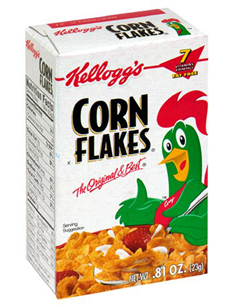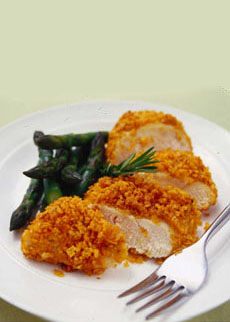Oven Fried Chicken With Corn Flakes Recipe & Corn Flakes History
|
July 6th is National Fried Chicken Day. Our favorite fried chicken recipe is breaded with Corn Flakes. We usually make this skillet fried chicken recipe, but here’s a “bake fry” recipe.
Of course, it’s breaded with Corn Flakes crumbs. Not only is the texture superior to flour, but the corn flakes add a delightful flavor note. (Panko, Japanese bread crumbs, provide the texture but not the flavor.) You can make this recipe with or without the chicken skin. We remove it to cut back on cholesterol. > The history of Corn Flakes is below. Ingredients |
||
|
Preparation
1. CRUSH. Crush corn flakes in a plastic bag with a rolling pin or wine bottle. Place crushed cereal in a shallow dish or pan. Set aside. 2. MIX. In medium mixing bowl, beat egg and milk slightly. Add flour, salt and pepper. Mix until smooth. Dip chicken in batter. Coat with cereal. Place in single layer, in shallow baking pan coated with cooking spray or foil lined. Drizzle with margarine. 3. Bake at 350° F about 1 hour or until chicken is tender, no longer pink and juices run clear. For food safety, internal temperature of the chicken should reach at least 165ºF. Do not cover pan or turn chicken while baking. Serve hot. |
||
|
CORN FLAKES HISTORY Corn flakes were developed by Dr. John Harvey Kellogg, a surgeon and vegetarian who built a sanitarium in Battle Creek, Michigan, and his brother Will Keith (W.K.) Kellogg, the sanitarium’s bookkeeper. Many of the patients were wealthy individuals with digestive problems. Seeking to develop a more digestible form of bread for the patients, the brothers Kellogg had just placed a sample of boiled wheat berries on a baking sheet when Dr. Kellogg was summoned to the operating room for an emergency. W.K. was also called away to supervise arrangements for the funeral of another patient. No one was watching the wheat berries. When they returned to their experiment, they ran the overcooked wheat berries through rollers and, to their surprise, found that each wheat berry formed a large, thin flake. The brothers had accidentally discovered the principle of tempering grains, and called the flaked wheat cereal Granose. They applied the same technique to create Corn Flakes, made from white corn grits; and rice flakes. |
 For breakfast or breading! Photo courtesy Kellogg. |
|
|
The first corn flakes appeared in 1898 and were called Sanitas Corn Flakes (presumably after the sanitarium, a questionable inspiration for a breakfast food). They were manufactured by Dr. Kellogg’s Sanitas Food Company. In 1906, W.K. Kellogg formed his own company for nationwide marketing of Corn Flakes (Dr. Kellogg preferred healthcare to business). C.W. Post, a former patient at the sanitarium, came out with his own corn flakes at about the same time. At first he called them Elijah’s Manna, and later changed the name to Post Toasties. The Kellogg’s Corn Flakes rooster actually has a name: Cornelius Rooster. The artwork was created in 1957 by Rena Ames Harding at the Leo Burnett Advertising Agency. It has been pictured on the front of Kellogg’s Corn Flakes box ever since. CHECK OUT WHAT’S HAPPENING ON OUR HOME PAGE, THENIBBLE.COM. |
||



